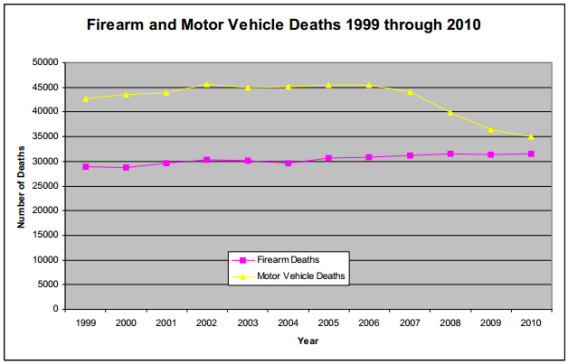The national gun-death rate would not be approaching that of motor vehicles if it weren't for the fact that the latter has dropped fairly drastically in the past half decade or so thanks to an increased effort to make the nation's roads and vehicles safer. Gun-rights advocates will point to the relatively subtle rise of the gun-death's purple line to argue that we don't need to pass more gun restrictions. Gun-control advocates will point to the more severe drop of the yellow line to make the case for what might happen if we were to.
It got me curious though....was that drop really do to some new law or set of regulations? I've been a licensed driver for over a decade now, and I couldn't recall any specific big changes in the past few years that change how I drive. Let's take a look at that chart again:
Between 2006 and 2007, there was a steep drop, and an even more profound one in 2008. Luckily for me I happen to have the chief hearings examiner for the State of NH Department of Motor Vehicles on speed dial*, so I gave him a call to see if he knew what was up.
Apparently there were no major changes to federal DUI law or any other major traffic laws in that time, so it wasn't a change in regulations. Individual states may have changed some things, but it seemed dubious that this could have had such a profound effect on a national scale. So I had one expert officially stumped.
I decided to investigate further, and came across a great article dealing with exactly this topic.
Apparently the traffic fatality rate actually ticked back up this year. The researcher quoted suggests that while policies and safety regulations have certainly helped, he expects that the poor economy did more to motivate changes in peoples driving than anything else. People go slower to save gas, and are more aware of the financial cost of getting a ticket or losing their license. Additionally, commuting miles tend to be low fatality, whereas driving for pleasure tends to be high fatality. In a bad economy, people do more of the former and less of the latter.
He also offers some awesome things to look for when assessing stats like these:
- Be cautious in assuming that a sudden, large drop in fatalities is in response to interventions related to vehicle design. It takes about 20 years to turn over the fleet.
- Don't expect most regulatory actions aimed at drivers to produce a sudden, huge drop in fatalities because such actions usually target only a portion of drivers (such as improvements in graduated driver licensing targeting young drivers only).
- Realize that any sudden, large reduction in fatalities is likely only an unintended byproduct of factors that influence the entire transportation system, such as a rapid change in the economy.
- Be aware that most rapid, underlying changes are transient, and therefore, their effects are mostly transient, too.
Read: don't pat yourself on the back too quickly. Be suspicious of anything that works too well.
*aka: my Dad

I love the way the teacher said "Let's take a look at that chart again."
ReplyDeleteWe need to develop an irrational hatred for any data that tells us what we want to hear.
Raise your hand if you'd like to say something please David.
Delete